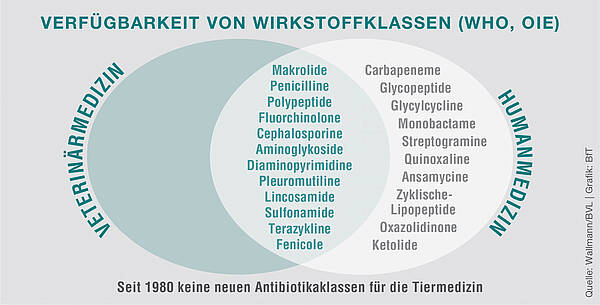Advances in veterinary medicine
In the summer, the federal government presented the evaluation report on the antibiotics minimization concept of the 16th drug amendment (AMG amendment). The concept was launched in 2014 with three goals: The use of antibiotics in fattening animals should be reduced, more careful use should be promoted with a view to the risk of resistance and effective control of the individual farm consumption quantities should be made possible. The track record in German stables is impressive.
With the 16th AMG amendment, the Federal Ministry of Agriculture was obliged to evaluate the effectiveness of the measures taken five years after they came into force. The evaluation report is now available. It shows that the determination of the therapy frequency index introduced with the amendment has once again significantly accelerated the use of antibiotics in livestock, which has been declining for several years. In 2014 alone, there was a nearly 30 percent drop in oral administration. According to the official quantity survey, the use of antibiotics has fallen by almost 2011 percent since 60.
Reduction across all drug classes...
The reduction was achieved across all drug classes. The substance classes fluoroquinolones and cephalosporins of the 3rd and 4th generation, which are classified as important in human medicine, only account for a small proportion of the total amount consumed. The amount of long-acting preparations is also only less than one percent of total consumption. Since the evaluation report only covers the data up to the second half of 2, the effects of further measures on the obligation to take an antibiogram and the use of antibiotics in animals in accordance with the approval, which were introduced with the amendment of the Veterinary Medicines Pharmacy Ordinance at the beginning of 2017, have not yet been taken into account. New 2018 veterinary sales figures show that the downward trends are continuing.
... and in all animal species
The use of antibiotics was found in all recorded animal species (Fattening pigs, fattening chickens, fattening turkeys, fattening calves and fattening cattle) can be reduced. With the exception of broilers, the indicators (therapy frequency, therapy index) are continuously declining or stagnating. The poultry industry wants to develop a strategy to significantly further reduce the use of antibiotics. In a research project over the past three years, the sector, together with science, has been examining possible approaches (especially for stabilizing the poultry intestinal flora).
It must be taken into account that a certain level of antibiotic use cannot be undershot, also for animal welfare reasons to ensure animal health.
Different classes of antibiotics are required in order to be able to effectively combat the entire spectrum of bacterial pathogens in the individual animal species in the future. This is also important to avoid resistance.
For the future, it will be important to ensure long-term animal health on farms through improved husbandry management and disease prevention concepts. It is to be expected that increasingly investment-intensive solutions on the farms or structural measures will become necessary.

The Federal Association for Animal Health provides further information: https://www.bft-online.de
